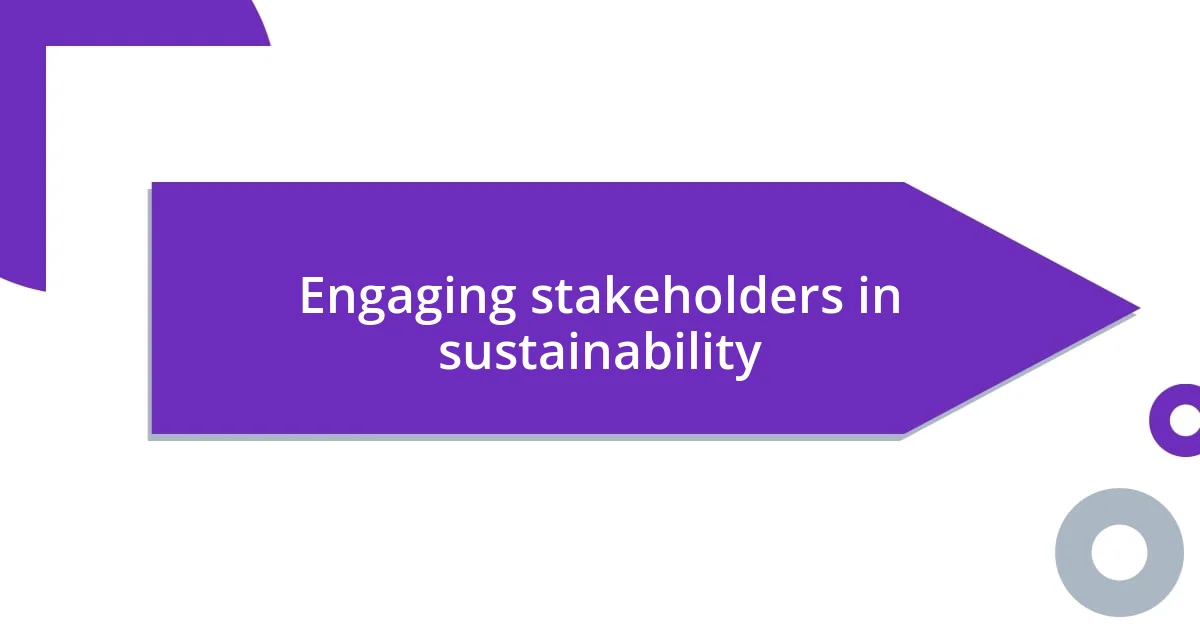Key takeaways:
- Sustainability in projects intertwines immediate needs with future legacy, emphasizing the importance of thoughtful decision-making and collective responsibility.
- Engaging stakeholders and defining clear sustainability goals fosters teamwork, creativity, and ownership, leading to richer project outcomes.
- Regular assessment and adaptation enhance sustainability efforts, highlighting the value of data-driven insights and a culture of continuous improvement.

Understanding sustainability in projects
Sustainability in projects goes beyond simply being environmentally friendly; it’s about creating a lasting impact that benefits both people and the planet. I recall a time when I was leading a community development project. We decided to integrate local materials, allowing not just for environmental benefits but also stimulating the local economy. It made me realize how interconnected our choices are. Have you ever considered how your decisions ripple through various aspects of a project?
When I think about sustainability, I often reflect on the balance between immediate needs and future consequences. In one project, we faced the challenge of using biodegradable packaging versus traditional materials. Though it was tempting to stick with what was easier, I knew the long-term benefits outweighed the initial pushback from team members. It’s crucial to ask ourselves, what legacy do we want to leave behind?
Incorporating sustainable practices can feel daunting, but I’ve found that it’s about taking small, intentional steps. For instance, during a recent initiative, we set specific goals for reducing waste and conserving resources. This focus not only engaged the team but also inspired creativity in finding innovative solutions. Have you experienced that spark when a team comes together to support a shared vision? That’s the beauty of prioritizing sustainability in any project.

Identifying sustainability goals
Identifying sustainability goals requires a thoughtful approach, blending personal values with project objectives. I remember sitting down with my team at the start of a new project, diving deep into our aspirations for sustainability. We brainstormed ideas, and through this process, I observed how passionate discussions often sparked innovative ideas. It wasn’t just about setting targets; it turned into a collective vision, revealing what truly mattered to each of us.
Here are some steps that helped us identify our sustainability goals:
- Assess current practices: We evaluated what we were already doing and pinpointed areas for improvement.
- Engage stakeholders: Gaining insights from everyone involved—be it team members or community participants—helped us understand diverse perspectives.
- Define clear objectives: We aimed small and realistic. Rather than overwhelming ourselves with big changes, we focused on achievable goals that could build momentum.
- Align with core values: Ensuring our goals resonated with our organization’s mission created a stronger commitment to our sustainability journey.
- Review and adapt: We established a process for ongoing evaluation, recognizing that our goals might evolve as we learned more.
Setting these goals transformed not just the project itself but also our connection as a team. It fostered a sense of ownership, making sustainability a shared responsibility rather than an obligation. Have you ever felt the satisfaction when a group collectively commits to a meaningful cause? That’s what makes the effort worthwhile.

Assessing project impact on environment
Assessing the environmental impact of a project is a vital step that often uncovers both challenges and opportunities. I vividly remember a project where we decided to use renewable energy sources. It was fascinating to see how energy assessments not only highlighted the benefits but also prompted us to rethink our resource allocation. Have you ever conducted such assessments, and did they lead you to unexpected insights?
I found that considering various environmental factors—like carbon footprint, waste generation, and biodiversity—helped frame our project in a broader context. For instance, when we analyzed how our construction practices impacted local wildlife habitats, it led to changes in our plans, ultimately fostering an ecosystem that benefited both nature and our project. Engaging with the data was enlightening; it was as if we could feel the environment responding to our choices.
What truly struck me was the experience of sharing these findings with the team. The passion ignited when we realized our collective decisions could lead to a positive environmental legacy. Just picture the excitement of brainstorming strategies to reduce waste or enhance energy efficiency—it’s moments like these that make the hard work worthwhile. Isn’t it rewarding when data transforms into a narrative that inspires action?
| Environmental Impact Factor | Description |
|---|---|
| Carbon Footprint | Measurement of greenhouse gas emissions from the project. |
| Waste Generation | Assessment of materials wasted during the project lifecycle. |
| Biodiversity | Impact on local flora and fauna, including habitats affected. |

Incorporating sustainable materials
When I started exploring sustainable materials for my projects, I experienced a real shift in mindset. I took the time to research everything from recycled metals to plant-based composites. I distinctly recall discovering bamboo—a material that’s not only fast-growing but incredibly versatile. It was eye-opening to see how choosing sustainable materials could not only reduce our environmental footprint but also inspire creativity in design. Have you ever felt that rush when you uncover a material that aligns perfectly with your sustainable vision?
There was a project where we opted for reclaimed wood instead of new lumber. The result was stunning, but what really struck me was the story behind each piece. Each plank held history and character, which added depth to our work. I remember walking through the warehouse, running my fingers along the grain, feeling a sense of connection to the past while doing something positive for the future. Isn’t it amazing how materials can carry such rich narratives, transforming a project into something deeply meaningful?
Additionally, incorporating sustainable materials often requires a shift in supplier relationships. I had to reach out to local vendors committed to eco-friendly practices. It was challenging but rewarding to see how these partnerships blossomed. The conversations we had were enlightening—they often included discussions on sourcing and environmental impact, creating a shared responsibility. I found immense satisfaction in these collaborations, knowing we were all invested in a sustainable future together. Have you found that working with local suppliers can enhance not just sustainability but also community ties?

Engaging stakeholders in sustainability
Engaging stakeholders in sustainability can be a transformative experience, both for the project and the individuals involved. I remember a time when we organized a workshop to bring together everyone from project managers to local community members. It was incredible to witness how open dialogue around sustainability not only fostered collaboration but also unearthed diverse perspectives that enriched our project. Have you ever experienced that magic when everyone feels they have a voice?
One powerful strategy I’ve seen work wonders is framing sustainability as a shared goal. In a recent project, we created visual impact reports that showcased potential environmental benefits and encouraged stakeholders to contribute their ideas. It felt invigorating to see the passion that emerged when people realized they had a personal stake in our sustainability efforts. I often found myself wondering, what if every stakeholder perceived sustainability as a fundamental aspect of their role?
Furthermore, I’ve learned that celebrating small wins can significantly strengthen engagement. After implementing a new recycling initiative, we shared the results in a celebratory meeting. The energy in the room was palpable as we acknowledged the collective efforts. This not only reinforced our commitment but also turned stakeholders into advocates for sustainable practices. It’s truly rewarding to turn your team into sustainability champions, isn’t it?

Measuring sustainability outcomes
Measuring sustainability outcomes is a journey that demands both creativity and analytical thinking. I vividly recall a project where we implemented a new tracking system to quantify our recycling efforts. The results were enlightening; not only did we reduce waste by 30%, but we also discovered patterns that highlighted areas for further improvement. Isn’t it fascinating how numbers can tell a compelling story about our impact?
Regular assessments became a vital part of our process. I remember one memorable team meeting where we looked at the data on energy consumption metrics. The energy surged in the room as we celebrated a 15% reduction—it was more than just a number; it was a testament to our shared commitment. It made me realize the power of transparency; when everyone sees the impact of their efforts, it ignites a fire of enthusiasm. Have you ever been motivated by seeing clear results in your projects?
To further enrich our measurement practices, I started incorporating not just quantitative metrics, but also qualitative feedback from community members. During a follow-up survey after a community event, some participants expressed how the project’s approach to sustainability influenced their own habits. It struck me deeply; this wasn’t merely about data points—it was about shifting mindsets. How often do we consider the stories behind the figures, and how can these narratives drive more profound change?

Adapting practices for continuous improvement
Adapting practices for continuous improvement really resonates with me because it’s all about being flexible and open to change based on what we learn along the way. I remember implementing a feedback loop during a project where we paused to reflect after each phase. Those moments of regrouping allowed the team to discuss what was working and what needed tweaking. Have you ever tried reflecting mid-project? It can lead to some of the most valuable insights.
There was a project where we decided to trial a new eco-friendly material, but halfway through, we realized it wasn’t performing as expected. Instead of sticking to it stubbornly, we held a brainstorming session to explore alternatives and engaged the entire team in finding solutions. The excitement was palpable as fresh ideas flowed. I often ponder how embracing failure as a learning opportunity can really shift our trajectory—don’t you think that’s where true innovation lies?
I also found that establishing a culture that encourages experimentation is essential. In one instance, we dedicated time for team members to pursue their green initiatives, even if they felt small. It was incredible to see projects blossom, from a vertical garden idea to an energy-efficient lighting plan. The stories that emerged not only enriched our overall strategy but also showcased the power of empowering every individual to make a difference. How can we cultivate that drive in our teams?














